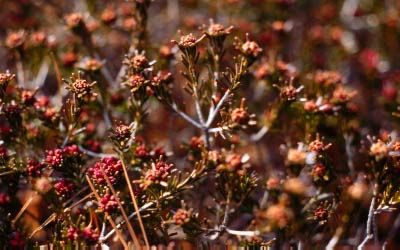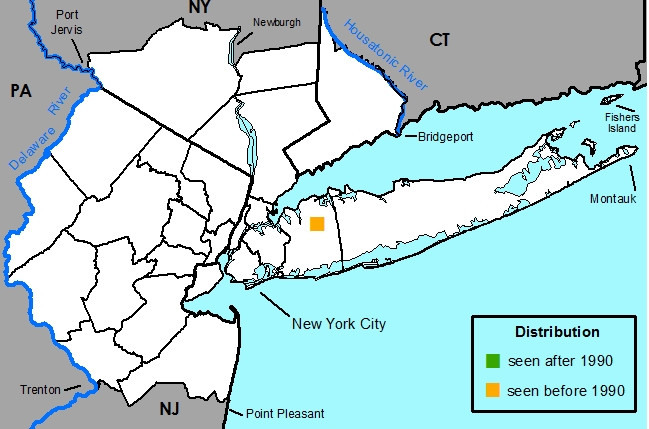Corema conradii (Torr.) Loudon - Broom Crowberry

Broom Crowberry
Photo © Steven Clemants, 1996, taken in Shawangunk Mountains, NY.
Common Names
Broom CrowberryField Identification
A small shrub with needle-like leaves and small, terminal, nonshowy flowers.Common names
Broom Crowberry
Conrad's Crowberry -- named for its discoverer, Prof. Solomon W. Conrad (Univ. of Pennsylvania, 1829-1831).
Poverty Grass
Nomenclature
*Empetrum conradii Torr., Ann. Lyc. Nat. Hist. New York 4: 83. 1837. *Corema arenaria Raf., New Fl. 3: 49. 1838, nom. illeg. (Art. 52.1). *Endammia ericoides Raf., New Fl. 3: 49. 1838 [alternate name], nom. illeg. (Art. 52.1). *Corema conradii (Torr.) Loudon, Encycl. Trees Shrubs 1092, f. 2039. 1842. *Tuckermania conradi (Torr.) Klotzsch, Arch. Naturgesch. 7(1): 248. 1841. *Oakesia conradi (Torr.) Tuck., London J. Bot. 1: 446. 1842, nom. illeg. (Art. 52.1). TYPE: Type not designated, two elements cited.Description
[Based on specimens from Massachusetts and Ocean Co., NJ.]HABIT perennial, evergreen, chamaephyte, shrubs, autotrophic, diclinous and dioecious, with fibrous roots, 0.15-0.35 m tall, not modified.
STEMS ascending or erect, round, not winged, "regular". Prickles absent. Bark furrowed or fibrous, exfoliating, dark reddish orange or dark gray. Branches erect or ascending, reddish orange or dark reddish orange or dark gray, round, not winged, 1-4 mm in diam. Twigs reddish orange or dark reddish orange or dark gray, not odoriferous, round, 0.5-1 mm in diam., smooth, hairs short and unbranched, erect or spreading, unicellular, uniseriate, gray or translucent, sparse to dense, throughout, glabrescent, without glands. Pith present, light yellow, round, continuous. Thorns absent. Aerial roots absent. Sap translucent. Resin absent.
LEAVES distichous (or subverticillate), 2 per node, spaced ± evenly along stem, appressed to stem or divergent from stem, simple. Stipules absent. Leaves sessile. Leaf: abaxial surface yellowish green, adaxial surface yellowish green, blades narrow oblong, revolute, symmetric, 0.25-0.45 cm long, 0.04-0.06 cm wide, coriaceous, base acute or cuneate, margin entire or ciliate, apex obtuse, abaxial surface hairs short and unbranched, erect, multicellular, multiseriate, translucent, sparse, throughout, not glabrescent, without glands, adaxial surface hairs short and unbranched, erect, multicellular, multiseriate, translucent, sparse, throughout, not glabrescent, without glands. Hyphodromous venation (?), veins 0. Leaf lobes absent. Spines absent. Tendrils absent.
INFLORESCENCES monomorphic, regular or, if dimorphic, female inflorescence simple, capitulum, terminal, probably a condensed raceme. Peduncle absent. Rachis absent. Bracts sessile, blades: abaxial surface dark orange-red, adaxial surface dark orange-red, ovate, plane, 1.2-2 mm long, 0.7-0.8 mm wide, base obtuse, margin ciliate, apex obtuse, abaxial surface glabrous, without glands, adaxial surface glabrous, without glands. Pedicel absent. Cupules absent.
FLOWERS serotinous, formed on long shoots, monomorphic, lacking either sepals or petals, unisexual, flowers dark orange-red, 3- to 4-merous, 1.6-3 mm long, 1-1.5 mm wide, 3-7 flowers per inflorescence, fragrance absent, perianth of one whorl. Calyx present, actinomorphic, crateriform, of free sepals, persistent, abaxial and adaxial surfaces the same color, dark reddish orange, 1.2-1.5 mm long, 1.5-2 mm wide. Sepals or sepal lobes 3-4, ovate or widely ovate or widely depressed ovate, 1.2-1.5 mm long, 0.8-1.5 mm wide, base obtuse, margin ciliate, apex obtuse, abaxial surface glabrous, without glands, adaxial surface glabrous, without glands. Epicalyx absent. Corolla absent. Gynoecium syncarpous. Carpels 3. Stigmas 3, linear. Styles not persistent, 1, 0.7-1 mm long. Ovary superior, 0.6 mm long, 0.4 mm wide. Locules 3. Placentation axile, basal axile. Stamens 0. Male flowers 3.5-4 mm long, 1.2-2.2 mm wide, 5-7, absent, perianth of one whorl. Perigon deciduous, abaxial and adaxial surfaces the same color, dark reddish orange, 1.7-2.2 mm long, 1.2-2.2 mm wide, crateriform. Tepals 3-4, 1.5:1 to 1.2:1, obovate, 1.1-1.7 mm long, 0.5-0.7 mm wide, base cuneate or acute, margin ciliate, apex obtuse, glabrous, without glands, 1. Androecium exserted, Stamens 2, 2-4.3 mm long. Anthers widely ellipsoid, opening along the long axis, opening entire length of anther, bithecal, dark red or dark reddish violet, glabrous. Filaments free, straight, dark red or dark reddish violet, glabrous. Staminodes absent.
FRUITS drupe, dark gray, globose, 1 mm long, 0.8 mm wide, glabrous, without glands.
SEEDS 3, light reddish orange, oblong, 1 mm long, 0.6 mm wide, wingless, not tailed.
Habitat
(Brown, 1913 (Dunwiddie, 1990) (Wherry, 1920)
Corema grows in dry acidic upland peaty soil. It is often associated with Arctostaphylos uva-ursi, Cladonia sp., Pinus rigida, and Quercus ilicifolia.
Rarity Status
Heritage global rank -- G4NJ -- endangered (Heritage rank: S1)
NY -- endangered (Heritage rank: S1)
Species Biology
FloweringUnknown [mid-March to May (Dunwiddie, 1990)].
Pollination
(Dunwiddie, 1990)Anemophily -- Apparently wind.
Fruiting
Unknown.
Dispersal
(Dunwiddie, 1990)Myrmechory -- Aphaenogaster piceum Wheeler is the most common ant dispersor. The fruits develop a white, fleshy structure at the base that can become as large as the fruit itself; these appear to be the attraction to the ant, which returns to its nest with the whole fruit and then discards the fruit minus the white body.
Germination
Unknown.